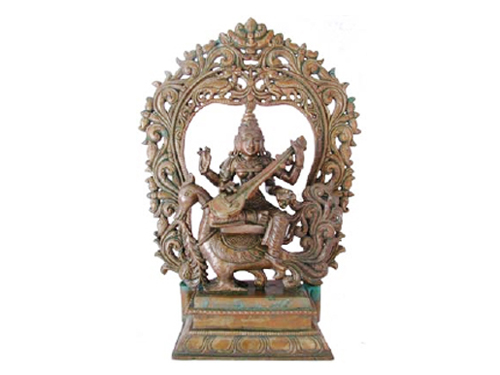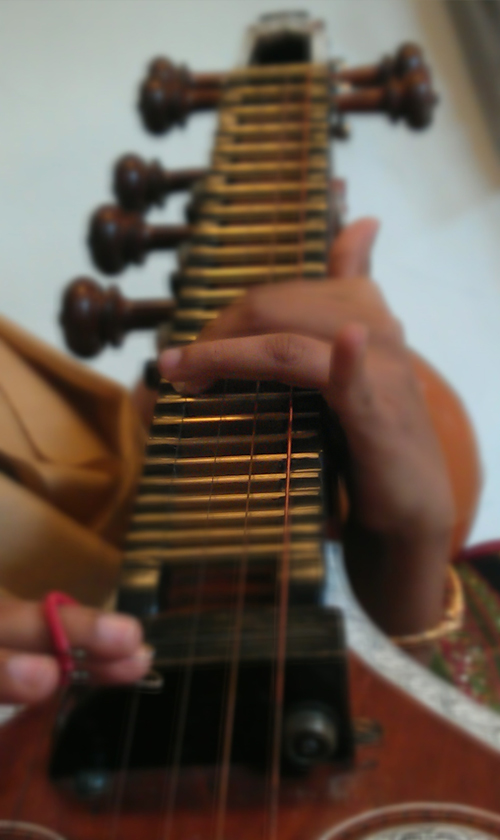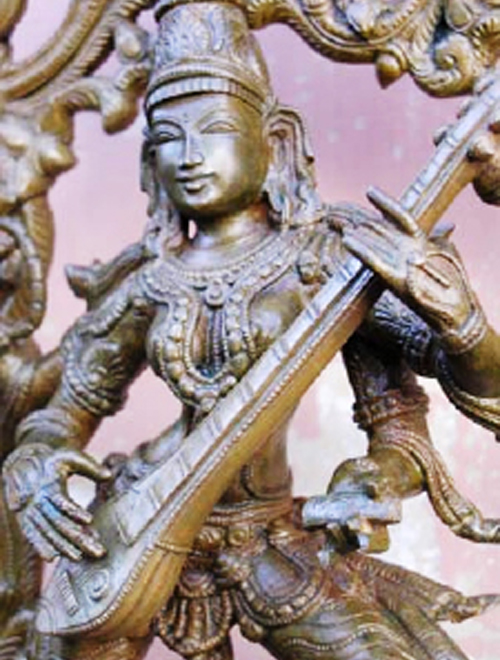Introduction

The Indian Veena has always been considered as an instrument of the Gods and hence the name ‘Divine instrument’ has been attributed to it. From the earliest times, the Veena has been a guiding star for the development of Indian Music in general. But Carnatic music cherished the Veena and the Yazh as gifts of the gods and through centuries of study and experiment, coaxed out of them a system of music that has no parallel in the whole world.
Veena is the favourite instrument of several important deities including Saraswathi, the goddess of arts and learning. The Veena handled by Goddess Saraswathi is known as ‘Kachchapi’. In the sloka ‘Vipanchya gãyanthi’ in Soundarya lahari, Jagadhguru Adi Shankaracharya portrays a beautiful scene in which Saraswathi plays the ‘Vipanchi’. Saraswathi is the goddess of all muses and is the Veena pustakadhaarini – one who holds the divine source of sound and wisdom. No picture, icon or poem of her or about her is therefore complete without the Veena and the pustaka (book).
Not only goddess Saraswathi, but goddess Parãshakthi also has a Veena in her hand. This is described by kãlidasa in the ‘Navarathnamala Sthothra’. He says that the goddess Parãshakthi plays the Veena with her fingertips and glows in the musical splendour created by the chaathurya of Saptha swaras. ‘sarigamapadani rathaan thaam veena sankratha kaantha hasthaan thaam’.
Mãthangi Devi, the goddess of Music is always depicted as holding a Veena in her hands. ‘Veena sankranta charu hastaa’. Goddess RajaMãthangi is the most important deity for Veena. She has to be worshipped fervently to understand the divine nuances of Veena. The ‘Mãthangi Shatkam’ is full of references to the Veena and we get phrases like ‘Veena Vadanavela Kampita siva sam’, ‘Veena rasanushangam’ and ‘Vama kucha nihita Veenam’. The sloka ‘Mãnikya Veenam upalalayantim’ is found as the last sloka of the ‘Mãthangi shatkam’ and the first sloka of the ‘Shyamala Dandakam’.
Lord Shiva is also depicted as being fond of Veena music. Saint Thyagaraja describes him as ‘Veena Vadhana loludu’ in his krithi ‘Mokshamugaladha’ in the Raga Sãramathi. ‘Veena Vãdhana loludou sivamano vidhamerugaru’. In this context, Shiva is known as ‘Veenadhara Dakshinamoorthy’. He is frequently depicted as holding a fretless Veena with a single gourd resting on his chest and teaching the wise ones like Sanaka. It is no wonder that the Veena is held in the hands of Lord Dakshinamoorthy, the god who confers pure Gnana or knowledge to release the soul from its bondage.
In Pallava or Chola temples of the South, Lord Dhakshinamoorthy is worshipped with a Veena in his hands. Lord Shiva was known as ‘Veena gãnapriya’, that is, as one who enjoys Veena music. Appar (one of the legendary Tamil poets and scholars) has also mentioned that Lord Siva himself is adept at the instrument in one of his poems. (‘Em Irai nal Veenai vasikkumme’). In ‘Thiruvilayadal Puranam’ Lord Shiva takes the form of a woodcutter and plays the Yãzh for the sake of his disciple, Panipataran. The lord stated that Yãzh or Veena is an instrument bubbling with life because ‘kuril’ and ‘Nedil’, that is, the musical dynamics (short and long) can be played on it with ease and without interruption.
Liberation is difficult for people who do not understand the mind of Lord Shiva, who enjoys playing his Veena in tune to the universal Naada. Attuning oneself to the divine mind of Shiva is Moksha itself. Lord Dhakshinamoorthy, therefore, conveys such ultimate Gnana through Veena.
Apart from Gods, many sages are depicted as Veena players, the most notable being the divine sage Narada. His Veena is known as ‘Mahathi’ and it was his inseparable companion. Thyagaraja describes this beautifully in his Krithi ‘Sri Narada’ (Kaanada) as ‘Veda Janitha Vara Veena Vaadhana Thathvajna’, meaning, Narada is one who knows the mysteries of ‘Veena Vaadhana’. The great sage, Narada did Nadopasana by tuning his consciousness to Veena.
Legends have it that Sage Agastya was also a Veena exponent and once had a competition with Ravana in Veena, wherein Maha Meru stood in judgement. In ‘Lalitha Sahasranamam’, Lord Hayagreeva refers to the Veena in Sloka 11, by saying “Nijasallaba mathurya vinirbarthsitha kachchapee”.
The saint of recent times Sri Raghavendra swami of Mantralaya was engaged in the contemplation of his soul while playing divine music on his Veena. He was an unparalleled exponent of the Veena. There is a story that he sang his own Bhairavi composition “Indhu enake Govinda”, playing Veena, just before entering Brindavana, for which song, his Golden Santhana Gopala Moorthi Vigraha came alive and danced, in full public view. And this did not happen in some ancient puranic time, but just about 300 years ago (1671 A.D).
Paramacharya Jagadguru Sri.Chandrasekharendra Saraswathi of Kanchi Kamakoti Peetam has stated in his ‘Deivathin kural’ that japam, dhyanam, puja and other rituals are not necessary for a real Veena artiste to achieve divine glory.
In ‘Sangita Rathnakara’, Sarangadeva says ‘Veena is an instrument that eradicates all evils and sins and bestows all good things in life.’
“Darshnasparshanechaasya Bhogaswargaapavargadhe Puneetho Viprahathyaadhi Paathakaihpathitham janam
Dandahshambhurumaa Thanthree kakubhah kamalapathihi Indiraapathrikaa Brahma Thumbu Naabhih saraswathee
Dorako Vaasukeerjeeva Sudhamshuh Saarika Ravihi Sarvadevamayee thasmaath Veeneeyam Sarvamangalaa”.
The meaning is like this: Even if one sees or touches the Veena it bestows comfort both during and after one’s lifetime. It cleanses and purifies all sins and evils of not only the downtrodden but also of those who have committed heinous crimes. The Author further attributes different Gods to the different parts of the Veena. Lord Siva in the body, Parvathi in the strings, Vishnu in the bridge, Lakshmi in the Main resonator, Brahma in the secondary resonator, Saraswathi in the naabhi (center part of the chest board which resonates the sound), Vasuki the serpent king in the pegs, Moon in the Jeevala (the cotton thread pieces used between the string and the bridge) and Sun God in the frets, and thus all Gods are invoked in the Veena, and hence it is indeed a very auspicious instrument.
The following are the names of some of the Veenas believed to have been played by celestial beings from ancient Vedic times.
- Lord Shiva – Rudra Veena
- Lord Brahma – Brahma Veena
- Goddess Saraswathi – Kachchapi Veena
- Nãrada – Mahathi Veena
- Rãvana – Rãvana Veena or Rãvana Hastha
- Raja Udayana – Ghoshavathee Veena (Mentioned in the ‘Swapnavasavadatta’ of the great poet Bhaasa)




